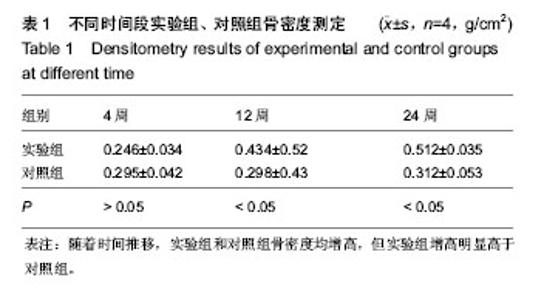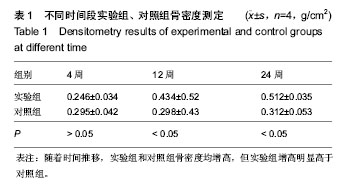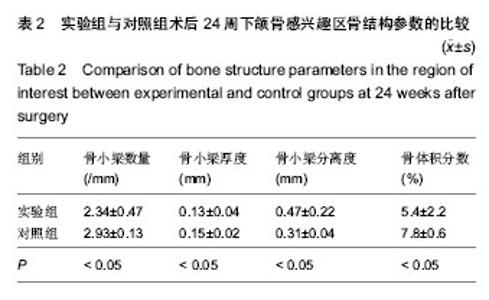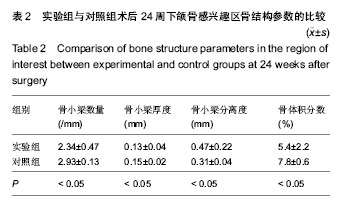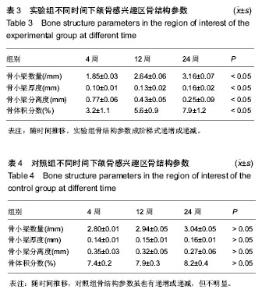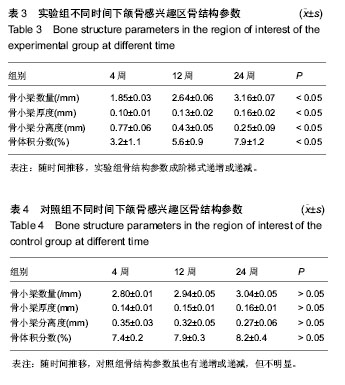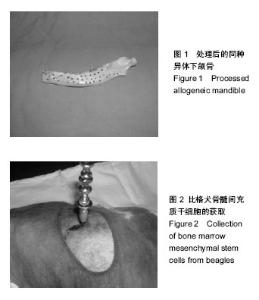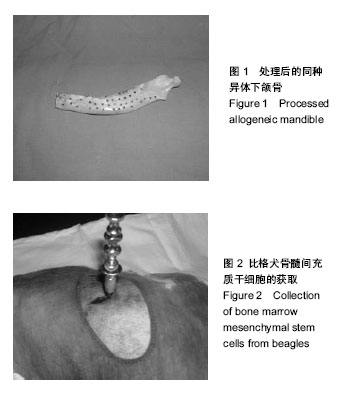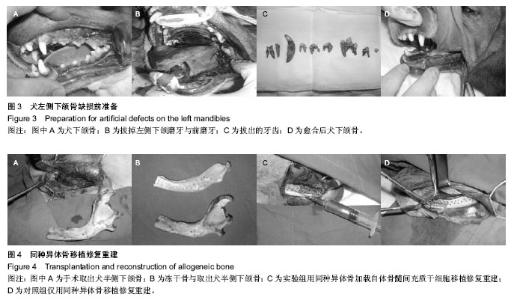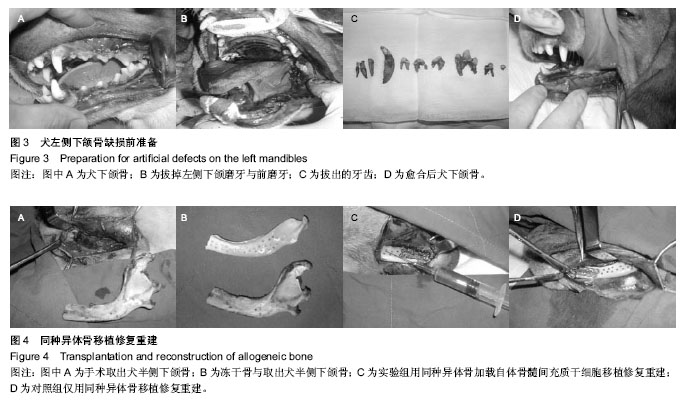| [1] 徐立群.下颌骨重建的原则与规范[J].中华临床医师杂志:电子版, 2012,6(19):5783-5785.
[2] Karagoz H, Eren F, Sever C, et al. Mandibular reconstruction after hemimandibulectomy.J Craniofac Surg. 2012;23(5): 1373-1374.
[3] Xingzhou Q, Chenping Z, Laiping Z,et al. Deep circumflex iliac artery flap combined with a costochondral graft for mandibular reconstruction.Br J Oral Maxillofac Surg. 2011; 49(8):597-601.
[4] 许亦权,胡敏.冷冻/冷冻干燥处理对犬下颌骨生物力学性能的影响[J].口腔医学研究,2006,22(3):232-235.
[5] 许亦权,胡敏,孙立群,等.同种异体下颌骨移植修复犬颞颌关节、下颌骨缺损的免疫学观察[J].中国组织工程研究与临床康复, 2008,12(53):10420-10424.
[6] 许亦权,胡敏,李其平,等.同种异体下颌骨移植修复犬颞颌关节、下颌骨的放射性核素和骨密度观察[J].口腔医学研究,2009, 25(5):537-540.
[7] 丛宪玲,王金成,王亮,等.骨库的特点及发展趋势[J].中国组织工程研究与临床康复,2011,15(33):6235-6238.
[8] 宁金沛,庞彤,梁柱德,等.同种异体骨库的建立及临床应用效果观察[J].广西医学,2003,25(10):1991-1993.
[9] 赵宝权,宋大勇,崔勇,等.常温储存的人同种异体骨制备[J].哈尔滨医科大学学报,2003,37(3):228-230.
[10] 李丹,胡蕴玉,袁志,等. 综合骨库各类骨移植材料的制备、消毒及保存[J].第四军医大学学报, 2001,22(22):2038-2042.
[11] 韩桂林,丁芳宝,梅举,等.体外诱导犬骨髓间充质干细胞向上皮样细胞分化的初步研究[J].第二军医大学学报, 2006,27(8):858- 862.
[12] 王淑红,张雄,张劲娥,等.新型多孔磷酸钙支架对骨髓间充质干细胞生物学行为的影响[J].华西口腔医学杂志, 2012,30(5): 544-548.
[13] 欧阳辉,刘维永,陈文生,等.应用犬骨髓间充质干细胞体外构建组织工程心脏瓣膜的实验研究[J].心脏杂志, 2005,17(4):337-340.
[14] 张近宝,顾春虎,刘维永,等. 犬骨髓间充质干细胞可诱导分化为组织工程瓣间质种子细胞[J]. 心脏杂志, 2006,18(5):489-491.
[15] 卫向阳,刘维永,欧阳辉,等.骨髓和静脉来源的间质细胞作为种子细胞的研究[J].中华实验外科杂志, 2005,22(7):777-779.
[16] 向虎,费小琛,卢清萍,等.骨组织工程材料PLGA/TCP的温度-黏度性能[J].清华大学学报:自然科学版, 2004,44(8):1100-1103.
[17] 胡卫岚,陈晓明,李湘南.骨组织工程材料β-磷酸三钙及其复合材料改性的研究进展[J].生物骨科材料与临床研究, 2008,5(4): 43-47.
[18] 谢德明.作为骨组织工程材料的聚α-羟基羧酸[J].生物学通报, 2000,35(6):22-23.
[19] 李明东,裴国献,奚廷斐,等.冻干同种异体骨粉与人淋巴细胞共培养时对细胞的影响[J].中国组织工程研究与临床康复, 2009, 13(8): 1517-1520.
[20] 李明东,奚延斐,金丹,等.冻干同种异体骨的免疫原性评价及免疫实验动物模型的选择[J].中华创伤骨科杂志, 2009,11(7): 671-674.
[21] 刘英飞,王涛,张平德.同种异体骨复合自体骨髓干细胞移植治疗良性骨肿瘤和瘤样病变[J].中国组织工程研究, 2013,17(31): 5652-5658.
[22] 印卫锋,陈苏,方煌,等.同种异体骨材料复合自体浓缩红骨髓移植治疗良性骨肿瘤和瘤样病变[J].中国组织工程研究与临床康复, 2009,13(16):3149-3152.
[23] 李光辉, 李锋, 夏仁云. 骨基质明胶复合自体红骨髓及同种异体骨修复骨缺损[J]. 中国矫形外科杂志, 2003,7(4):181-183.
[24] Schek RM, Taboas JM, Hollister SJ, et al. Tissue engineering osteochondral implants for temporomandibular joint repair.Orthod Craniofac Res. 2005;8(4):313-319.
[25] 翁雨来,曹谊林,Vacanti CA.组织工程化人形下颌骨髁状突的实验研究[J].上海口腔医学,2000,9(2):94-96.
[26] Yin F,Meng CY,Lu RF,et al.Bone marrow mesenchymal stem cells repair spinal cord ischemia/reperfusion injury by promoting axonal growth and anti-autophagy.Neural Regen Res. 2014;9 (18): 1665-1671.
[27] Alhadlaq A, Mao JJ. Tissue-engineered osteochondral constructs in the shape of an articular condyle. J Bone Joint Surg Am. 2005;87(5):936-944.
[28] Li Y,Hua XM,Man WW,et al.Are bone marrow regenerative cells ideal seed cells for the treatment of cerebral ischemia? Neural Regen Res. 2013;8(13): 1201-1209
[29] 王军,毕龙,白建萍,等.显微CT与组织切片技术在骨形态计量研究中的比较[J].中国矫形外科杂志,2009,17(5):381-384.
[30] Borah B, Gross GJ, Dufresne TE,et al. Three-dimensional microimaging (MRmicroI and microCT), finite element modeling, and rapid prototyping provide unique insights into bone architecture in osteoporosis.Anat Rec. 2001;265(2): 101-110.
[31] Gross GJ, Dufresne TE, Smith T, et al. Bone architecture and image synthesis. Morphologie. 1999;83(261):21-24.
[32] Hildebrand T, Laib A, Müller R,et al.Direct three-dimensional morphometric analysis of human cancellous bone: microstructural data from spine, femur, iliac crest, and calcaneus.J Bone Miner Res. 1999;14(7):1167-1174.
[33] Yang J, Pham SM, Crabbe DL. High-resolution Micro-CT evaluation of mid- to long-term effects of estrogen deficiency on rat trabecular bone. Acad Radiol. 2003;10(10):1153-1158.
[34] McLaughlin F, Mackintosh J, Hayes BP,et al. Glucocorticoid-induced osteopenia in the mouse as assessed by histomorphometry, microcomputed tomography, and biochemical markers.Bone. 2002;30(6):924-930.
[35] 万东东,姜文学,胡茂忠,等.同种异体骨脱钙骨基质联合BMP修复兔桡骨骨缺损的实验研究[J].天津医科大学学报, 2009,15(3): 485-488.
[36] 刘亮,王东,大段同种异体骨移植复合BMP2和TGF-β2对兔桡骨中段骨缺损愈合的影响[J].中国矫形外科杂志, 2007,15(9): 702-705.
[37] 刘晓阳,李广润,刘洪涛,等.硫酸钙人工骨/骨髓间充质干细胞构建组织工程化骨诱导脊柱融合[J].中国组织工程研究,2014, 18(21):3281-3286.
[38] 李涛,宋国栋,包崇云,等.骨髓间充质干细胞作为干细胞参与生物材料异位诱导成骨[J].中国组织工程研究与临床康复,2010, 14(21): 3819-3822.
[39] 朱肖奇,贺用礼,马雪峰,等.生物衍生骨与骨髓间充质干细胞复合修复免桡骨大段缺损[J].中国组织工程研究与临床康复,2009, 13(3):417-422. |
